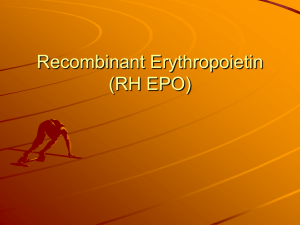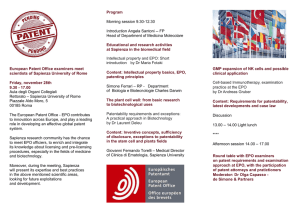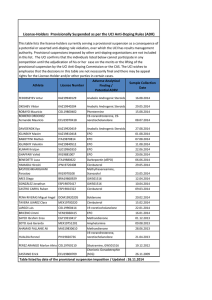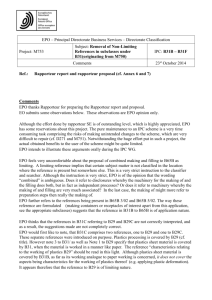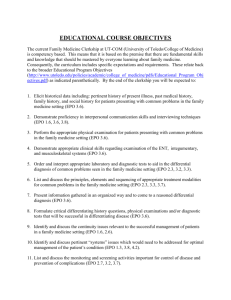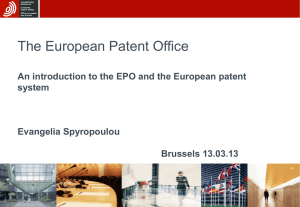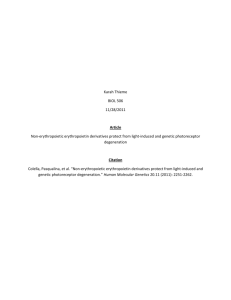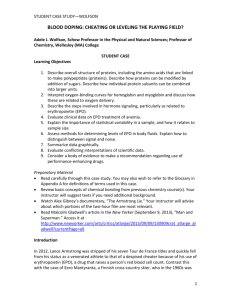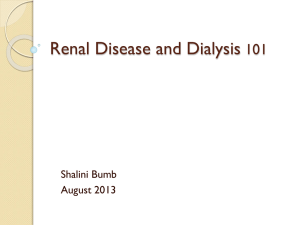Ultrapure dialysate
advertisement
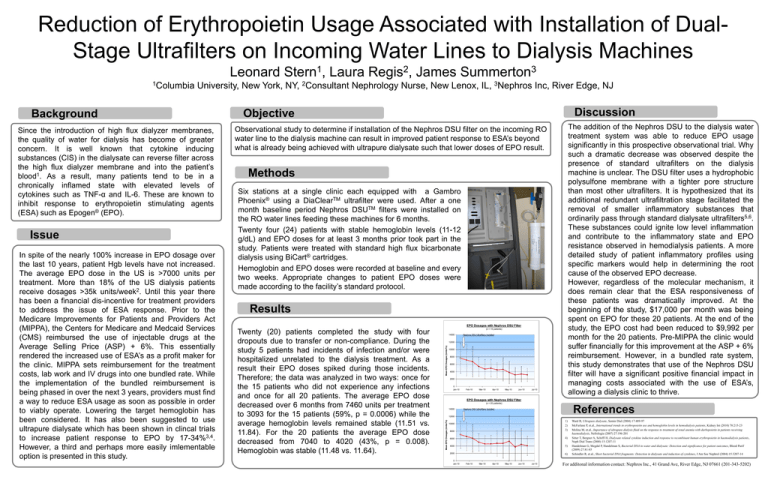
Reduction of Erythropoietin Usage Associated with Installation of DualStage Ultrafilters on Incoming Water Lines to Dialysis Machines Leonard University, New York, NY, Since the introduction of high flux dialyzer membranes, the quality of water for dialysis has become of greater concern. It is well known that cytokine inducing substances (CIS) in the dialysate can reverse filter across the high flux dialyzer membrane and into the patient’s blood1. As a result, many patients tend to be in a chronically inflamed state with elevated levels of cytokines such as TNF-α and IL-6. These are known to inhibit response to erythropoietin stimulating agents (ESA) such as Epogen® (EPO). Issue In spite of the nearly 100% increase in EPO dosage over the last 10 years, patient Hgb levels have not increased. The average EPO dose in the US is >7000 units per treatment. More than 18% of the US dialysis patients receive dosages >35k units/week2. Until this year there has been a financial dis-incentive for treatment providers to address the issue of ESA response. Prior to the Medicare Improvements for Patients and Providers Act (MIPPA), the Centers for Medicare and Medcaid Services (CMS) reimbursed the use of injectable drugs at the Average Selling Price (ASP) + 6%. This essentially rendered the increased use of ESA’s as a profit maker for the clinic. MIPPA sets reimbursement for the treatment costs, lab work and IV drugs into one bundled rate. While the implementation of the bundled reimbursement is being phased in over the next 3 years, providers must find a way to reduce ESA usage as soon as possible in order to viably operate. Lowering the target hemoglobin has been considered. It has also been suggested to use ultrapure dialysate which has been shown in clincal trials to increase patient response to EPO by 17-34%3,4. However, a third and perhaps more easily imlementable option is presented in this study. 2Consultant James 3 Summerton 3Nephros Nephrology Nurse, New Lenox, IL, Inc, River Edge, NJ Discussion Objective The addition of the Nephros DSU to the dialysis water treatment system was able to reduce EPO usage significantly in this prospective observational trial. Why such a dramatic decrease was observed despite the presence of standard ultrafilters on the dialysis machine is unclear. The DSU filter uses a hydrophobic polysulfone membrane with a tighter pore structure than most other ultrafilters. It is hypothesized that its additional redundant ultrafiltration stage facilitated the removal of smaller inflammatory substances that ordinarily pass through standard dialysate ultrafilters5,6. These substances could ignite low level inflammation and contribute to the inflammatory state and EPO resistance observed in hemodialysis patients. A more detailed study of patient inflammatory profiles using specific markers would help in determining the root cause of the observed EPO decrease. However, regardless of the molecular mechanism, it does remain clear that the ESA responsiveness of these patients was dramatically improved. At the beginning of the study, $17,000 per month was being spent on EPO for these 20 patients. At the end of the study, the EPO cost had been reduced to $9,992 per month for the 20 patients. Pre-MIPPA the clinic would suffer financially for this improvement at the ASP + 6% reimbursement. However, in a bundled rate system, this study demonstrates that use of the Nephros DSU filter will have a significant positive financial impact in managing costs associated with the use of ESA’s, allowing a dialysis clinic to thrive. Observational study to determine if installation of the Nephros DSU filter on the incoming RO water line to the dialysis machine can result in improved patient response to ESA’s beyond what is already being achieved with ultrapure dialysate such that lower doses of EPO result. Methods Six stations at a single clinic each equipped with a Gambro Phoenix® using a DiaClearTM ultrafilter were used. After a one month baseline period Nephros DSUTM filters were installed on the RO water lines feeding these machines for 6 months. Twenty four (24) patients with stable hemoglobin levels (11-12 g/dL) and EPO doses for at least 3 months prior took part in the study. Patients were treated with standard high flux bicarbonate dialysis using BiCart® cartridges. Hemoglobin and EPO doses were recorded at baseline and every two weeks. Appropriate changes to patient EPO doses were made according to the facility’s standard protocol. Results EPO Dosages with Nephros DSU Filter Twenty (20) patients completed the study with four dropouts due to transfer or non-compliance. During the study 5 patients had incidents of infection and/or were hospitalized unrelated to the dialysis treatment. As a result their EPO doses spiked during those incidents. Therefore; the data was analyzed in two ways: once for the 15 patients who did not experience any infections and once for all 20 patients. The average EPO dose decreased over 6 months from 7460 units per treatment to 3093 for the 15 patients (59%, p = 0.0006) while the average hemoglobin levels remained stable (11.51 vs. 11.84). For the 20 patients the average EPO dose decreased from 7040 to 4020 (43%, p = 0.008). Hemoglobin was stable (11.48 vs. 11.64). (n = 15 patients) 14000 Nephros DSU Ultrafilters Installed 12000 Mean EPO Dosages (Units/Tx) Background Laura 2 Regis , 10000 8000 6000 4000 2000 0 Jan-10 Feb-10 Mar-10 Apr-10 May-10 Jun-10 Jul-10 EPO Dosages with Nephros DSU Filter (n = 20 patients) 14000 References Nephros DSU Ultrafilters Installed 12000 Mean EPO Dosages (Units/Tx) 1Columbia 1 Stern , 8000 1) 2) 3) 6000 4) 4000 5) 2000 6) 10000 0 Jan-10 Feb-10 Mar-10 Apr-10 May-10 Jun-10 Jul-10 Ward R, Ultrapure dialysate, Semin Dial (2004) 17:489-97 McFarlane P, et.al., International trends in erythropoietin use and hemoglobin levels in hemodialysis patients, Kidney Int (2010) 78:215-23 Molina M, et.al., Importance of ultrapure dialysis fluid on the response to treatment of renal anemia with darbepoietin in patients receiving haemodialysis, Nefrologia (2007) 27:196-201 Sitter T, Bergner A, Schiffl H, Dialysate related cytokine induction and response to recombinant human erythropoietin in haemodialysis patients, Neph Dial Trans (2000) 15:1207-11 Handelman G, Megdal P, Handelman S, Bacterial DNA in water and dialysate: Detection and significance for patient outcomes, Blood Purif (2009) 27:81-85 Schindler R, et.al., Short bacterial DNA fragments: Detection in dialysate and induction of cytokines, J Am Soc Nephrol (2004) 15:3207-14 For additonal information contact: Nephros Inc., 41 Grand Ave, River Edge, NJ 07661 (201-343-5202)

